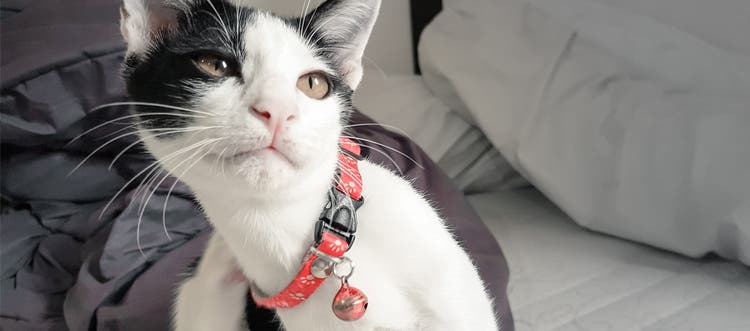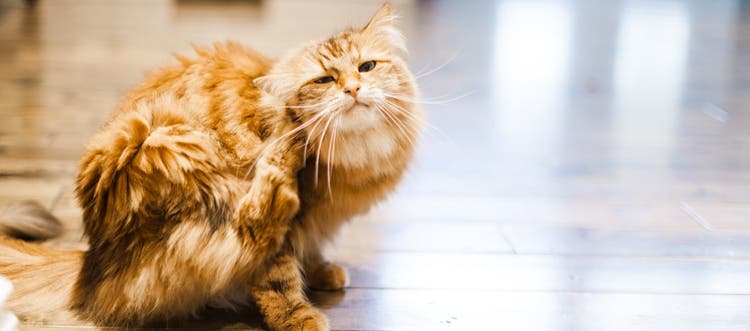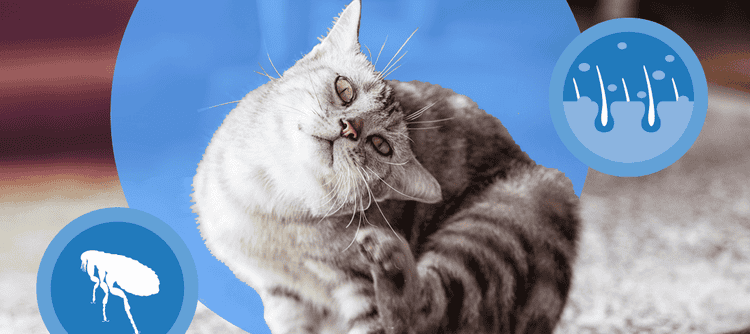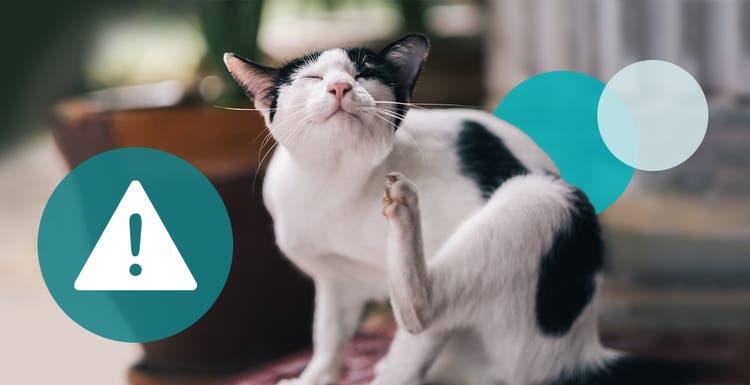How fleas and flea bites can affect cats.

Fleas are one of the most common parasites that can affect cats, and cats that go outside on a regular basis will likely come in contact with fleas. But even indoor cats can get fleas if the parasites hitch a ride into your home on you or another pet.
The Cat Flea Basics
Fleas are tiny wingless insects, typically smaller than two millimeters, that live on your cat’s body. They feed on blood and lay eggs in your cat’s fur, which then drop off throughout your home. A single flea can lay up to 2,000 eggs in its lifetime, and its full life cycle — from egg to larva to pupa to adult — can take place over just a few weeks. Although they don’t live in human hair, fleas do bite humans — especially on the ankles and lower legs — if they cannot find a pet to jump onto.
Why Flea Bites Can Be Dangerous for Cats
Flea bites are painful and itchy for your cat, and they can cause a range of additional problems.
Flea Allergy Dermatitis (FAD)
Flea allergy dermatitis (FAD) is an allergy to flea saliva that can set off an intense reaction from just a few flea bites. It’s also one of the most common causes of itchiness in cats. When fleas bite, substances in their saliva enter your cat’s skin and can trigger an immune response. This can cause intense skin irritation that extends well beyond the bite locations, resulting in:
- Hair loss around the tail, belly and inner thighs
- Skin that may look sore and crusty
- Skin infections that can make the problem even worse
If your cat is experiencing FAD, you may see or feel small, scab-like bumps on their skin. These symptoms will continue until the fleas are controlled.
Anemia
If a large number of fleas bite and feed on your cat, your pet can develop anemia, which means your cat is losing too much blood. This is a serious medical condition, especially in kittens and elderly cats, that must be promptly addressed through veterinary care. Symptoms of anemia in cats include:
- Weakness
- Lethargy
- Rapid breathing
Though rare, anemia can even lead to death in cats, especially with heavy flea infestations.
Tapeworm
If your cat swallows fleas infected with tapeworms while grooming, your cat can end up with a tapeworm infection. Tapeworms attach to your cat’s intestines with their sucker-like mouthparts, where they grow and steal nutrients from your cat. If your cat has tapeworms, you may see pieces of the worms stuck around their backside. These pieces, which look like white grains of rice, are actually packets of tapeworm eggs that you may see moving upon closer inspection. Once the outer casing of these packets dries out, eggs are released into the environment where a developing flea can swallow them and repeat the cycle. Tapeworms rarely cause health issues in cats; however, they can sometimes lead to abdominal pain and diarrhea, as well as itchiness around the anus.
Bartonella
Cat fleas can also spread disease, including a bacterium called Bartonella (which can cause cat scratch disease in people). Cats most commonly contract Bartonella, also known as bartonellosis, through close skin contact with infected flea feces. Infected fleas can shed the bacteria in their feces, dropping their waste right onto your cat and creating the opportunity for infection. While cats usually don’t show direct symptoms from this infection, a wide variety of medical conditions have been linked with Bartonella infections, including:
- Mouth and gum disease
- Eye inflammation
- Heart disease
A main concern with Bartonella infections is that cats can carry the bacteria in their systems for long periods of time, potentially passing it to other feeding fleas and, in turn, other cats.
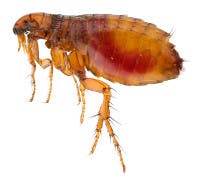
How to Spot a Flea Infestation
It can be difficult to spot fleas on cats, and the first symptom you may notice is scratching. You can check your cat regularly by combing your pet gently with a flea comb and shaking the fur onto a damp piece of white tissue. If dark specks (“flea dirt”) appear and turn reddish brown, this indicates your cat has fleas. In many cases, it may not be obvious that your pet has fleas, as fleas burrow deep into your pet’s fur and aren’t always easily visible.
How to Get Rid of Fleas on Your Cat and in Your Home
The first step in dealing with a flea infestation is to give your cat a flea treatment, such as a topical, tablet, collar or spray. To help prevent fleas in the first place, use an effective flea prevention product for cats throughout the year. Consider keeping all pets in your household on a monthly flea-control program using a product that kills fleas through contact, so fleas don’t have to bite your cat to die.
To remove fleas from your home, wash your cat’s bedding on the hottest possible setting, vacuum your cat’s favorite snoozing spots and use a household flea spray throughout your home. Read our comprehensive guide for more information and helpful tips.
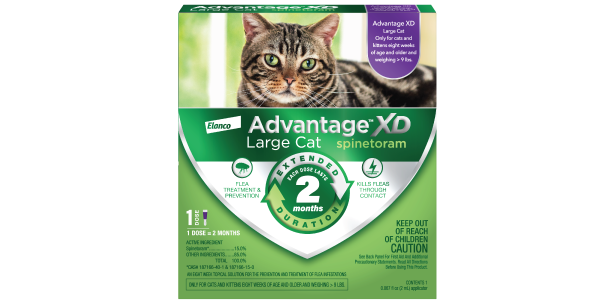
Advantage® XD (spinetoram)
Kills fleas for two months with one dose, outlasting the typical six-week flea life cycle — and the monthly competition.
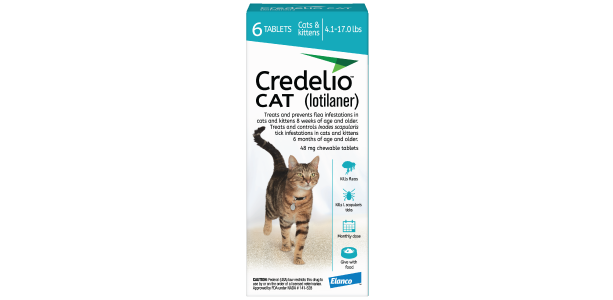
Credelio® CAT (lotilaner)
Protect your feline friend with Credelio Cat, the first and only flea and tick chewable for cats.

Seresto® Flea & Tick Collar for Cats
An easy-to-use, odorless, non-greasy collar that kills and repels fleas and ticks for 8 continuous months.

Advantage® II for Cats
A convenient, monthly topical application that kills fleas through contact so they don't have to bite your cat to die.
Credelio® CAT (lotilaner)
Indications:
Credelio CAT kills adult fleas and is indicated for the treatment and prevention of flea infestations for one month in cats and kittens 8 weeks of age and older and weighing 2 pounds or greater.
Credelio CAT is also indicated for treatment and control of black-legged tick infestations for one month in cats and kittens 6 months of age and older and weighing 2 pounds or greater.
Important Safety Information:
Lotilaner is a member of the isoxazoline class of drugs. This class has been associated with neurologic adverse reactions including tremors, incoordination, and seizures. Neurologic adverse reactions have been reported in cats receiving isoxazoline class drugs, even in cats without a history of neurologic disorders. Use with caution in cats with a history of neurologic disorders. The safety of Credelio CAT has not been established in breeding, pregnant and lactating cats. The effectiveness of Credelio CAT against black-legged ticks in kittens less than 6 months of age has not been evaluated. The most frequently reported adverse reactions are weight loss, rapid breathing and vomiting. For complete safety information, please see Credelio CAT product label or ask your veterinarian.
